Report: Partnership Evaluation, Porter's 5 Forces, Little Dessert Shop
VerifiedAdded on 2022/12/30
|8
|2089
|45
Report
AI Summary
This report analyzes 'Little Dessert Shop', a partnership between Mary and Sue, evaluating its structure and advantages. It applies Porter's 5 Forces to assess the competitive landscape, including the threat of new entrants, bargaining power of suppliers and buyers, threat of substitutes, and rivalry among existing players. The report also examines the impact of macro-environmental factors such as economic, social, and technological factors, and suggests strategies for business improvement. The analysis focuses on how the dessert shop can achieve competitive advantage through effective management of these forces and factors. The report concludes by summarizing the key findings and recommendations for the business's growth and development.

TOP 12869 ESSAY
Paraphrase This Document
Need a fresh take? Get an instant paraphrase of this document with our AI Paraphraser
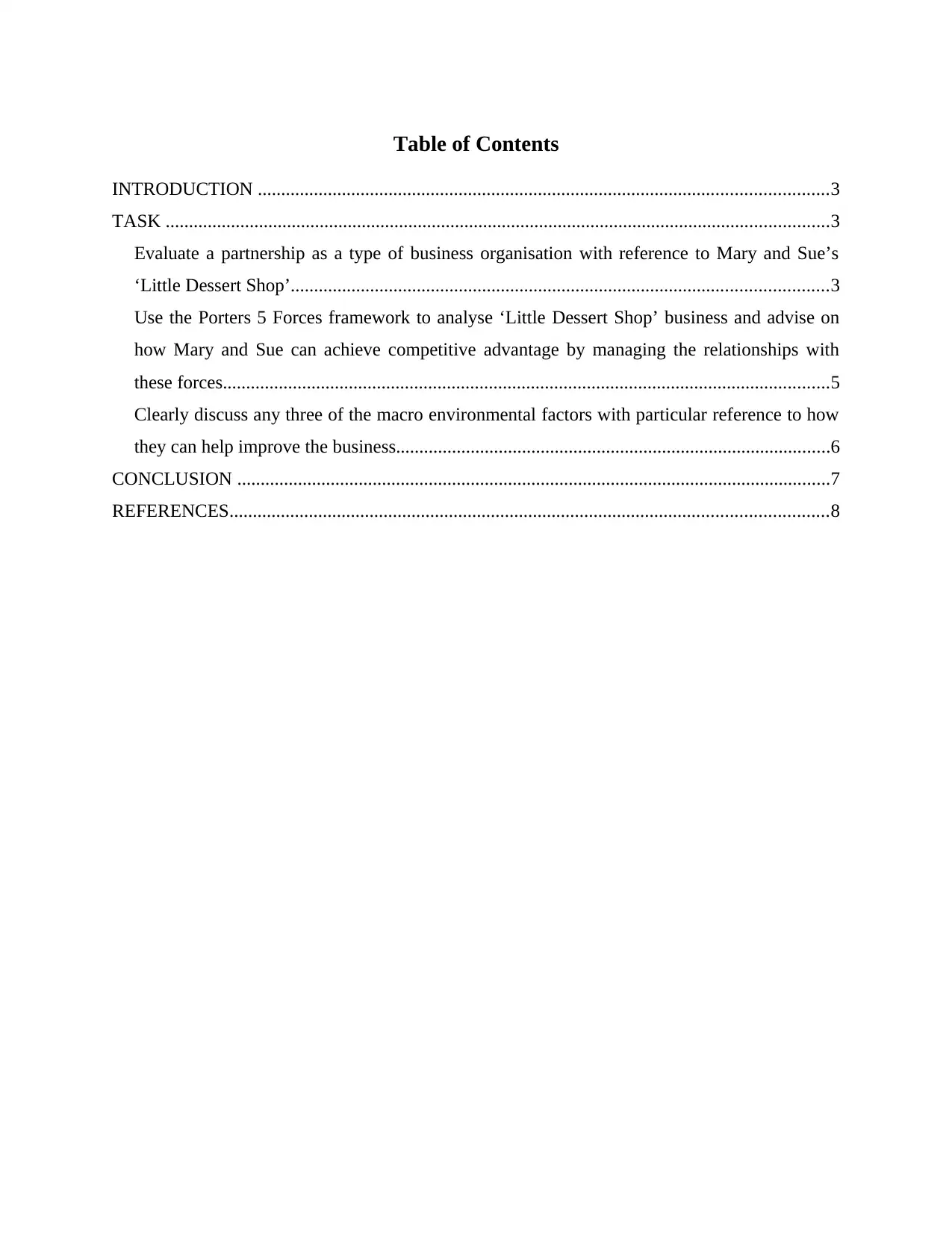
Table of Contents
INTRODUCTION ..........................................................................................................................3
TASK ..............................................................................................................................................3
Evaluate a partnership as a type of business organisation with reference to Mary and Sue’s
‘Little Dessert Shop’...................................................................................................................3
Use the Porters 5 Forces framework to analyse ‘Little Dessert Shop’ business and advise on
how Mary and Sue can achieve competitive advantage by managing the relationships with
these forces..................................................................................................................................5
Clearly discuss any three of the macro environmental factors with particular reference to how
they can help improve the business.............................................................................................6
CONCLUSION ...............................................................................................................................7
REFERENCES................................................................................................................................8
INTRODUCTION ..........................................................................................................................3
TASK ..............................................................................................................................................3
Evaluate a partnership as a type of business organisation with reference to Mary and Sue’s
‘Little Dessert Shop’...................................................................................................................3
Use the Porters 5 Forces framework to analyse ‘Little Dessert Shop’ business and advise on
how Mary and Sue can achieve competitive advantage by managing the relationships with
these forces..................................................................................................................................5
Clearly discuss any three of the macro environmental factors with particular reference to how
they can help improve the business.............................................................................................6
CONCLUSION ...............................................................................................................................7
REFERENCES................................................................................................................................8
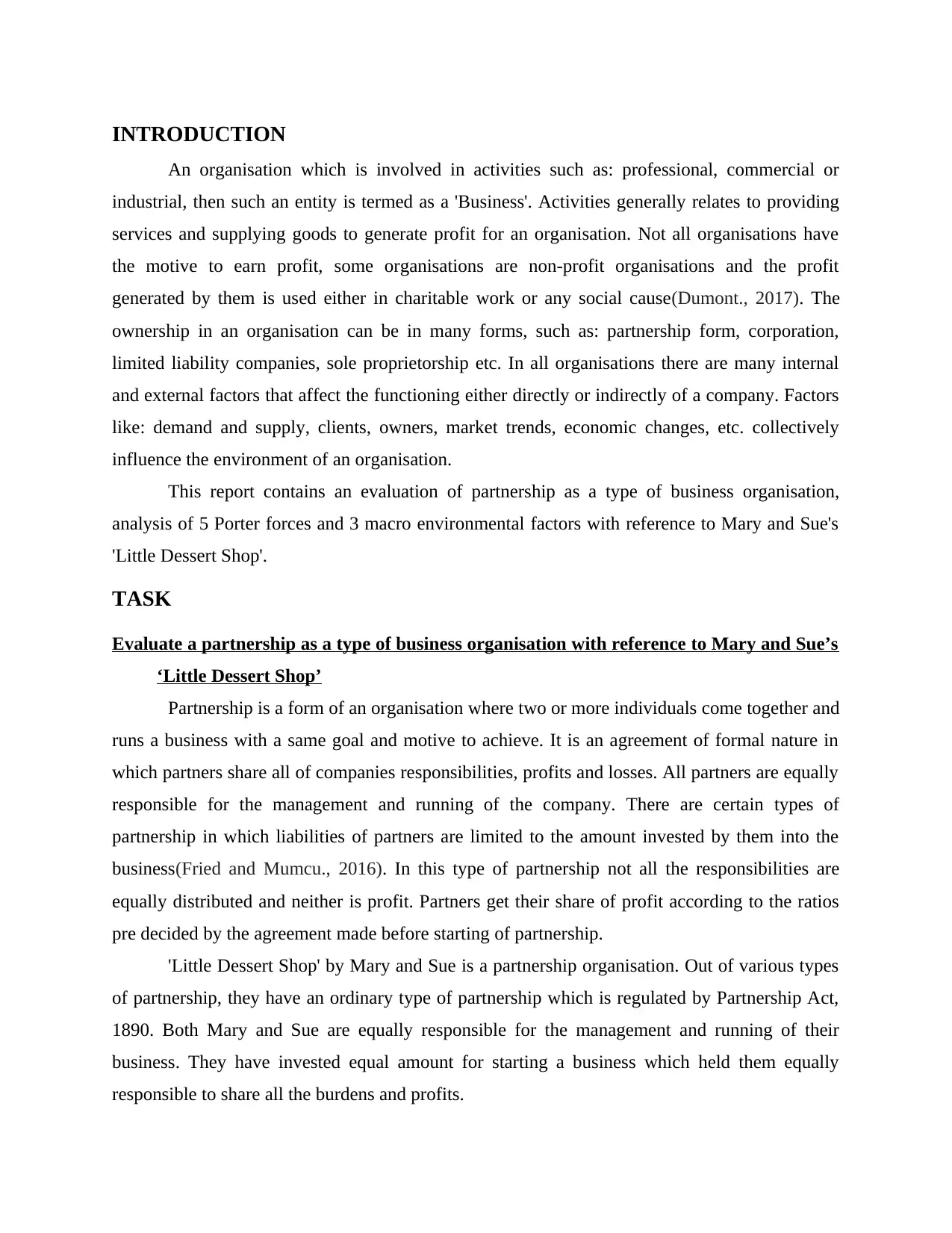
INTRODUCTION
An organisation which is involved in activities such as: professional, commercial or
industrial, then such an entity is termed as a 'Business'. Activities generally relates to providing
services and supplying goods to generate profit for an organisation. Not all organisations have
the motive to earn profit, some organisations are non-profit organisations and the profit
generated by them is used either in charitable work or any social cause(Dumont., 2017). The
ownership in an organisation can be in many forms, such as: partnership form, corporation,
limited liability companies, sole proprietorship etc. In all organisations there are many internal
and external factors that affect the functioning either directly or indirectly of a company. Factors
like: demand and supply, clients, owners, market trends, economic changes, etc. collectively
influence the environment of an organisation.
This report contains an evaluation of partnership as a type of business organisation,
analysis of 5 Porter forces and 3 macro environmental factors with reference to Mary and Sue's
'Little Dessert Shop'.
TASK
Evaluate a partnership as a type of business organisation with reference to Mary and Sue’s
‘Little Dessert Shop’
Partnership is a form of an organisation where two or more individuals come together and
runs a business with a same goal and motive to achieve. It is an agreement of formal nature in
which partners share all of companies responsibilities, profits and losses. All partners are equally
responsible for the management and running of the company. There are certain types of
partnership in which liabilities of partners are limited to the amount invested by them into the
business(Fried and Mumcu., 2016). In this type of partnership not all the responsibilities are
equally distributed and neither is profit. Partners get their share of profit according to the ratios
pre decided by the agreement made before starting of partnership.
'Little Dessert Shop' by Mary and Sue is a partnership organisation. Out of various types
of partnership, they have an ordinary type of partnership which is regulated by Partnership Act,
1890. Both Mary and Sue are equally responsible for the management and running of their
business. They have invested equal amount for starting a business which held them equally
responsible to share all the burdens and profits.
An organisation which is involved in activities such as: professional, commercial or
industrial, then such an entity is termed as a 'Business'. Activities generally relates to providing
services and supplying goods to generate profit for an organisation. Not all organisations have
the motive to earn profit, some organisations are non-profit organisations and the profit
generated by them is used either in charitable work or any social cause(Dumont., 2017). The
ownership in an organisation can be in many forms, such as: partnership form, corporation,
limited liability companies, sole proprietorship etc. In all organisations there are many internal
and external factors that affect the functioning either directly or indirectly of a company. Factors
like: demand and supply, clients, owners, market trends, economic changes, etc. collectively
influence the environment of an organisation.
This report contains an evaluation of partnership as a type of business organisation,
analysis of 5 Porter forces and 3 macro environmental factors with reference to Mary and Sue's
'Little Dessert Shop'.
TASK
Evaluate a partnership as a type of business organisation with reference to Mary and Sue’s
‘Little Dessert Shop’
Partnership is a form of an organisation where two or more individuals come together and
runs a business with a same goal and motive to achieve. It is an agreement of formal nature in
which partners share all of companies responsibilities, profits and losses. All partners are equally
responsible for the management and running of the company. There are certain types of
partnership in which liabilities of partners are limited to the amount invested by them into the
business(Fried and Mumcu., 2016). In this type of partnership not all the responsibilities are
equally distributed and neither is profit. Partners get their share of profit according to the ratios
pre decided by the agreement made before starting of partnership.
'Little Dessert Shop' by Mary and Sue is a partnership organisation. Out of various types
of partnership, they have an ordinary type of partnership which is regulated by Partnership Act,
1890. Both Mary and Sue are equally responsible for the management and running of their
business. They have invested equal amount for starting a business which held them equally
responsible to share all the burdens and profits.
⊘ This is a preview!⊘
Do you want full access?
Subscribe today to unlock all pages.

Trusted by 1+ million students worldwide
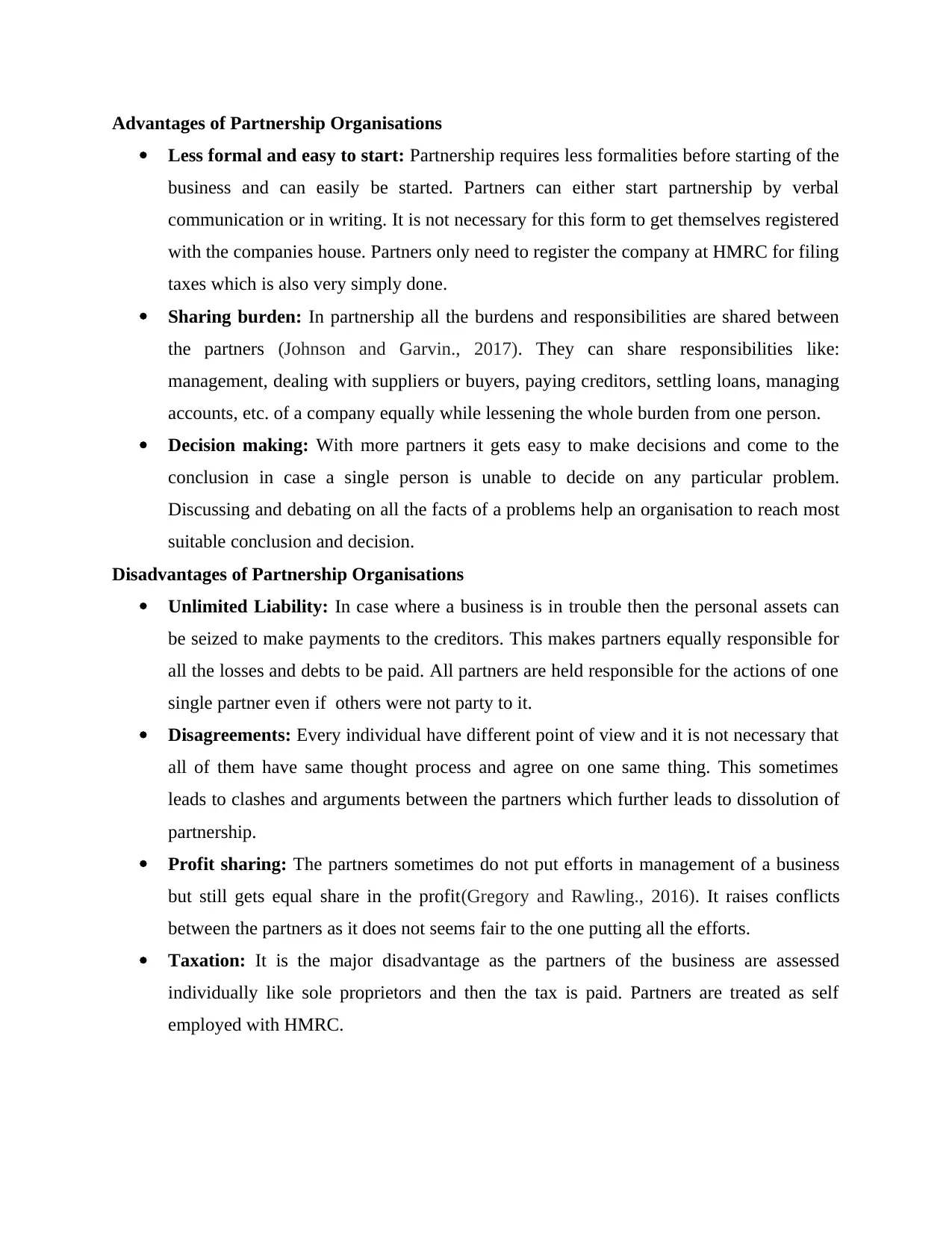
Advantages of Partnership Organisations
Less formal and easy to start: Partnership requires less formalities before starting of the
business and can easily be started. Partners can either start partnership by verbal
communication or in writing. It is not necessary for this form to get themselves registered
with the companies house. Partners only need to register the company at HMRC for filing
taxes which is also very simply done.
Sharing burden: In partnership all the burdens and responsibilities are shared between
the partners (Johnson and Garvin., 2017). They can share responsibilities like:
management, dealing with suppliers or buyers, paying creditors, settling loans, managing
accounts, etc. of a company equally while lessening the whole burden from one person.
Decision making: With more partners it gets easy to make decisions and come to the
conclusion in case a single person is unable to decide on any particular problem.
Discussing and debating on all the facts of a problems help an organisation to reach most
suitable conclusion and decision.
Disadvantages of Partnership Organisations
Unlimited Liability: In case where a business is in trouble then the personal assets can
be seized to make payments to the creditors. This makes partners equally responsible for
all the losses and debts to be paid. All partners are held responsible for the actions of one
single partner even if others were not party to it.
Disagreements: Every individual have different point of view and it is not necessary that
all of them have same thought process and agree on one same thing. This sometimes
leads to clashes and arguments between the partners which further leads to dissolution of
partnership.
Profit sharing: The partners sometimes do not put efforts in management of a business
but still gets equal share in the profit(Gregory and Rawling., 2016). It raises conflicts
between the partners as it does not seems fair to the one putting all the efforts.
Taxation: It is the major disadvantage as the partners of the business are assessed
individually like sole proprietors and then the tax is paid. Partners are treated as self
employed with HMRC.
Less formal and easy to start: Partnership requires less formalities before starting of the
business and can easily be started. Partners can either start partnership by verbal
communication or in writing. It is not necessary for this form to get themselves registered
with the companies house. Partners only need to register the company at HMRC for filing
taxes which is also very simply done.
Sharing burden: In partnership all the burdens and responsibilities are shared between
the partners (Johnson and Garvin., 2017). They can share responsibilities like:
management, dealing with suppliers or buyers, paying creditors, settling loans, managing
accounts, etc. of a company equally while lessening the whole burden from one person.
Decision making: With more partners it gets easy to make decisions and come to the
conclusion in case a single person is unable to decide on any particular problem.
Discussing and debating on all the facts of a problems help an organisation to reach most
suitable conclusion and decision.
Disadvantages of Partnership Organisations
Unlimited Liability: In case where a business is in trouble then the personal assets can
be seized to make payments to the creditors. This makes partners equally responsible for
all the losses and debts to be paid. All partners are held responsible for the actions of one
single partner even if others were not party to it.
Disagreements: Every individual have different point of view and it is not necessary that
all of them have same thought process and agree on one same thing. This sometimes
leads to clashes and arguments between the partners which further leads to dissolution of
partnership.
Profit sharing: The partners sometimes do not put efforts in management of a business
but still gets equal share in the profit(Gregory and Rawling., 2016). It raises conflicts
between the partners as it does not seems fair to the one putting all the efforts.
Taxation: It is the major disadvantage as the partners of the business are assessed
individually like sole proprietors and then the tax is paid. Partners are treated as self
employed with HMRC.
Paraphrase This Document
Need a fresh take? Get an instant paraphrase of this document with our AI Paraphraser
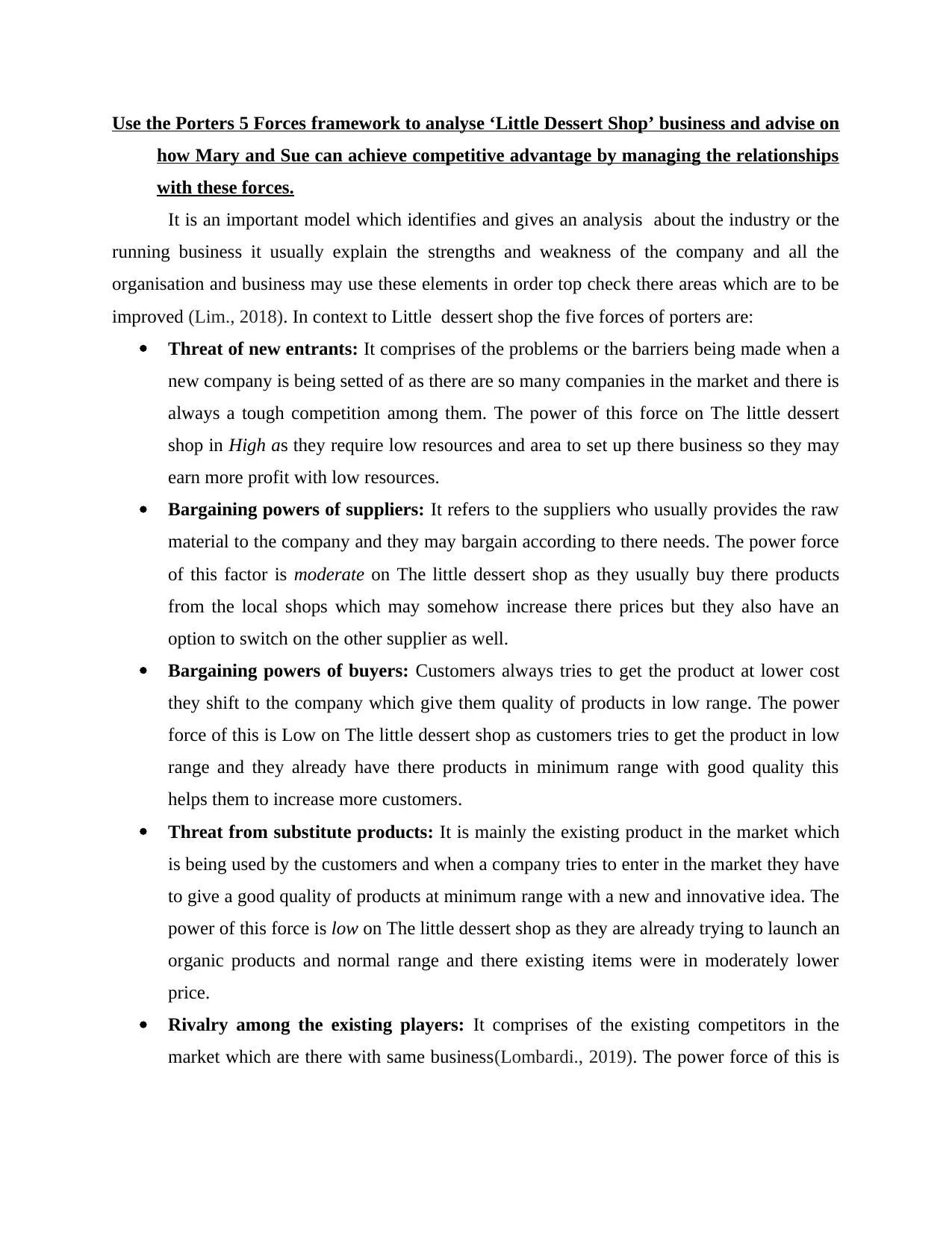
Use the Porters 5 Forces framework to analyse ‘Little Dessert Shop’ business and advise on
how Mary and Sue can achieve competitive advantage by managing the relationships
with these forces.
It is an important model which identifies and gives an analysis about the industry or the
running business it usually explain the strengths and weakness of the company and all the
organisation and business may use these elements in order top check there areas which are to be
improved (Lim., 2018). In context to Little dessert shop the five forces of porters are:
Threat of new entrants: It comprises of the problems or the barriers being made when a
new company is being setted of as there are so many companies in the market and there is
always a tough competition among them. The power of this force on The little dessert
shop in High as they require low resources and area to set up there business so they may
earn more profit with low resources.
Bargaining powers of suppliers: It refers to the suppliers who usually provides the raw
material to the company and they may bargain according to there needs. The power force
of this factor is moderate on The little dessert shop as they usually buy there products
from the local shops which may somehow increase there prices but they also have an
option to switch on the other supplier as well.
Bargaining powers of buyers: Customers always tries to get the product at lower cost
they shift to the company which give them quality of products in low range. The power
force of this is Low on The little dessert shop as customers tries to get the product in low
range and they already have there products in minimum range with good quality this
helps them to increase more customers.
Threat from substitute products: It is mainly the existing product in the market which
is being used by the customers and when a company tries to enter in the market they have
to give a good quality of products at minimum range with a new and innovative idea. The
power of this force is low on The little dessert shop as they are already trying to launch an
organic products and normal range and there existing items were in moderately lower
price.
Rivalry among the existing players: It comprises of the existing competitors in the
market which are there with same business(Lombardi., 2019). The power force of this is
how Mary and Sue can achieve competitive advantage by managing the relationships
with these forces.
It is an important model which identifies and gives an analysis about the industry or the
running business it usually explain the strengths and weakness of the company and all the
organisation and business may use these elements in order top check there areas which are to be
improved (Lim., 2018). In context to Little dessert shop the five forces of porters are:
Threat of new entrants: It comprises of the problems or the barriers being made when a
new company is being setted of as there are so many companies in the market and there is
always a tough competition among them. The power of this force on The little dessert
shop in High as they require low resources and area to set up there business so they may
earn more profit with low resources.
Bargaining powers of suppliers: It refers to the suppliers who usually provides the raw
material to the company and they may bargain according to there needs. The power force
of this factor is moderate on The little dessert shop as they usually buy there products
from the local shops which may somehow increase there prices but they also have an
option to switch on the other supplier as well.
Bargaining powers of buyers: Customers always tries to get the product at lower cost
they shift to the company which give them quality of products in low range. The power
force of this is Low on The little dessert shop as customers tries to get the product in low
range and they already have there products in minimum range with good quality this
helps them to increase more customers.
Threat from substitute products: It is mainly the existing product in the market which
is being used by the customers and when a company tries to enter in the market they have
to give a good quality of products at minimum range with a new and innovative idea. The
power of this force is low on The little dessert shop as they are already trying to launch an
organic products and normal range and there existing items were in moderately lower
price.
Rivalry among the existing players: It comprises of the existing competitors in the
market which are there with same business(Lombardi., 2019). The power force of this is
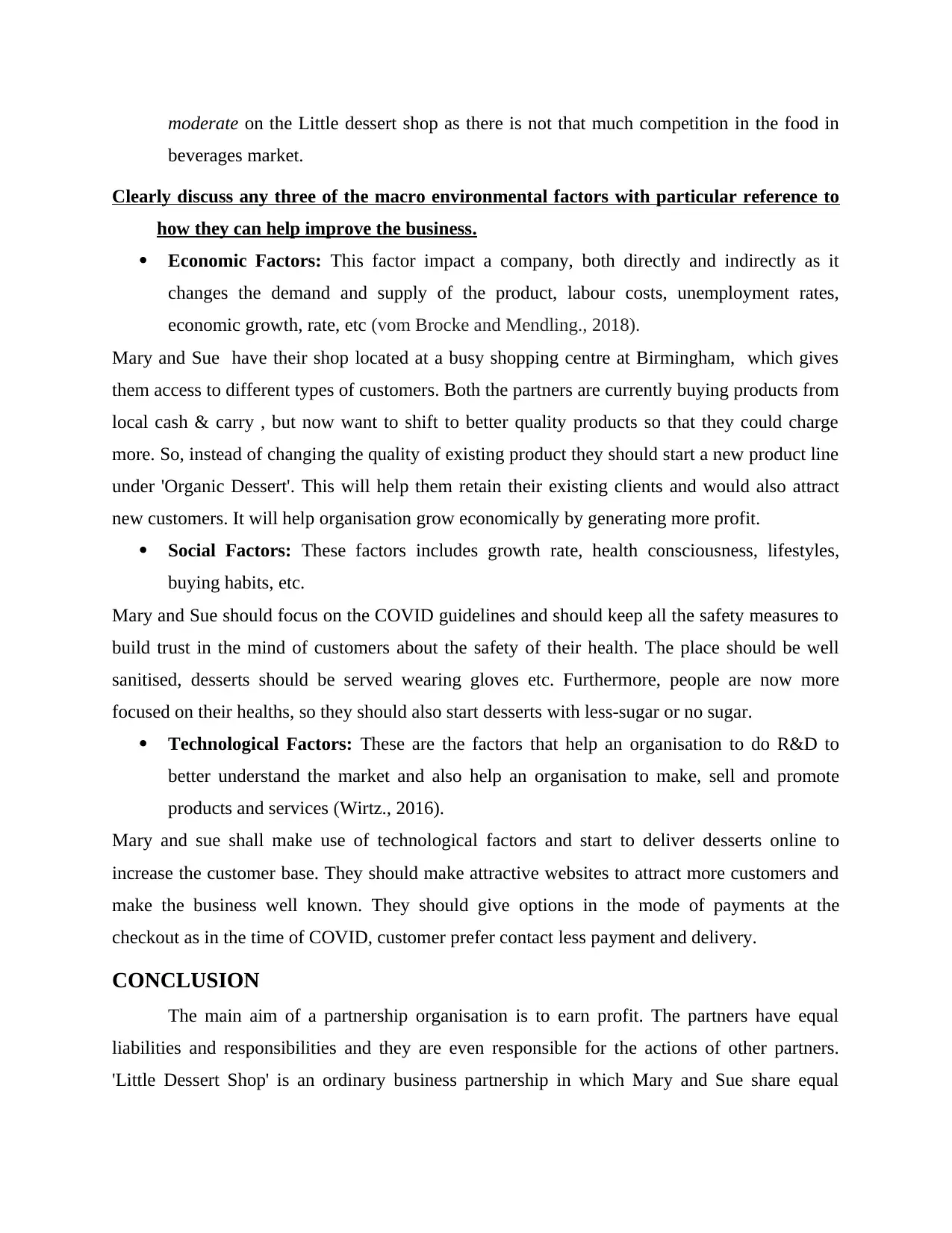
moderate on the Little dessert shop as there is not that much competition in the food in
beverages market.
Clearly discuss any three of the macro environmental factors with particular reference to
how they can help improve the business.
Economic Factors: This factor impact a company, both directly and indirectly as it
changes the demand and supply of the product, labour costs, unemployment rates,
economic growth, rate, etc (vom Brocke and Mendling., 2018).
Mary and Sue have their shop located at a busy shopping centre at Birmingham, which gives
them access to different types of customers. Both the partners are currently buying products from
local cash & carry , but now want to shift to better quality products so that they could charge
more. So, instead of changing the quality of existing product they should start a new product line
under 'Organic Dessert'. This will help them retain their existing clients and would also attract
new customers. It will help organisation grow economically by generating more profit.
Social Factors: These factors includes growth rate, health consciousness, lifestyles,
buying habits, etc.
Mary and Sue should focus on the COVID guidelines and should keep all the safety measures to
build trust in the mind of customers about the safety of their health. The place should be well
sanitised, desserts should be served wearing gloves etc. Furthermore, people are now more
focused on their healths, so they should also start desserts with less-sugar or no sugar.
Technological Factors: These are the factors that help an organisation to do R&D to
better understand the market and also help an organisation to make, sell and promote
products and services (Wirtz., 2016).
Mary and sue shall make use of technological factors and start to deliver desserts online to
increase the customer base. They should make attractive websites to attract more customers and
make the business well known. They should give options in the mode of payments at the
checkout as in the time of COVID, customer prefer contact less payment and delivery.
CONCLUSION
The main aim of a partnership organisation is to earn profit. The partners have equal
liabilities and responsibilities and they are even responsible for the actions of other partners.
'Little Dessert Shop' is an ordinary business partnership in which Mary and Sue share equal
beverages market.
Clearly discuss any three of the macro environmental factors with particular reference to
how they can help improve the business.
Economic Factors: This factor impact a company, both directly and indirectly as it
changes the demand and supply of the product, labour costs, unemployment rates,
economic growth, rate, etc (vom Brocke and Mendling., 2018).
Mary and Sue have their shop located at a busy shopping centre at Birmingham, which gives
them access to different types of customers. Both the partners are currently buying products from
local cash & carry , but now want to shift to better quality products so that they could charge
more. So, instead of changing the quality of existing product they should start a new product line
under 'Organic Dessert'. This will help them retain their existing clients and would also attract
new customers. It will help organisation grow economically by generating more profit.
Social Factors: These factors includes growth rate, health consciousness, lifestyles,
buying habits, etc.
Mary and Sue should focus on the COVID guidelines and should keep all the safety measures to
build trust in the mind of customers about the safety of their health. The place should be well
sanitised, desserts should be served wearing gloves etc. Furthermore, people are now more
focused on their healths, so they should also start desserts with less-sugar or no sugar.
Technological Factors: These are the factors that help an organisation to do R&D to
better understand the market and also help an organisation to make, sell and promote
products and services (Wirtz., 2016).
Mary and sue shall make use of technological factors and start to deliver desserts online to
increase the customer base. They should make attractive websites to attract more customers and
make the business well known. They should give options in the mode of payments at the
checkout as in the time of COVID, customer prefer contact less payment and delivery.
CONCLUSION
The main aim of a partnership organisation is to earn profit. The partners have equal
liabilities and responsibilities and they are even responsible for the actions of other partners.
'Little Dessert Shop' is an ordinary business partnership in which Mary and Sue share equal
⊘ This is a preview!⊘
Do you want full access?
Subscribe today to unlock all pages.

Trusted by 1+ million students worldwide
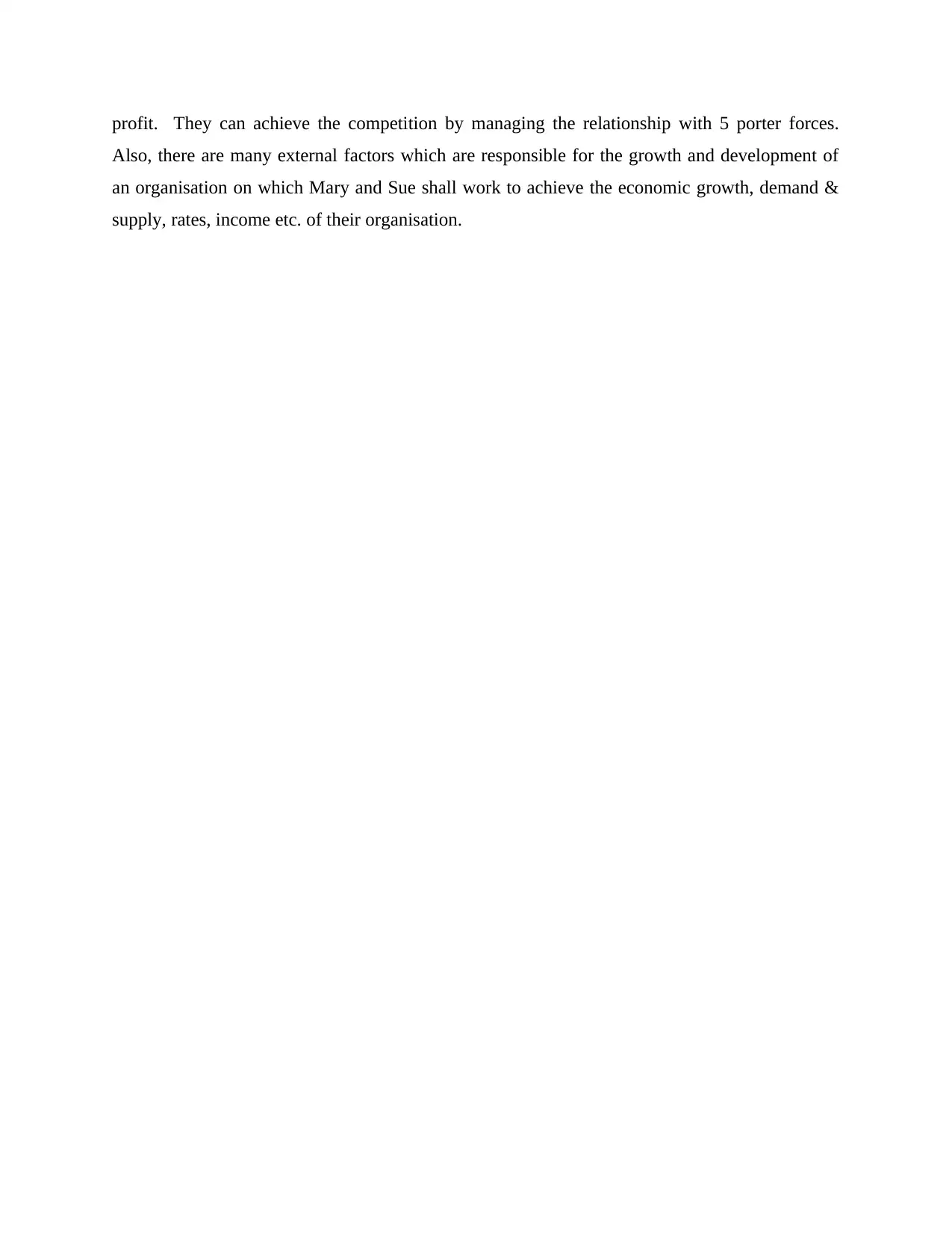
profit. They can achieve the competition by managing the relationship with 5 porter forces.
Also, there are many external factors which are responsible for the growth and development of
an organisation on which Mary and Sue shall work to achieve the economic growth, demand &
supply, rates, income etc. of their organisation.
Also, there are many external factors which are responsible for the growth and development of
an organisation on which Mary and Sue shall work to achieve the economic growth, demand &
supply, rates, income etc. of their organisation.
Paraphrase This Document
Need a fresh take? Get an instant paraphrase of this document with our AI Paraphraser
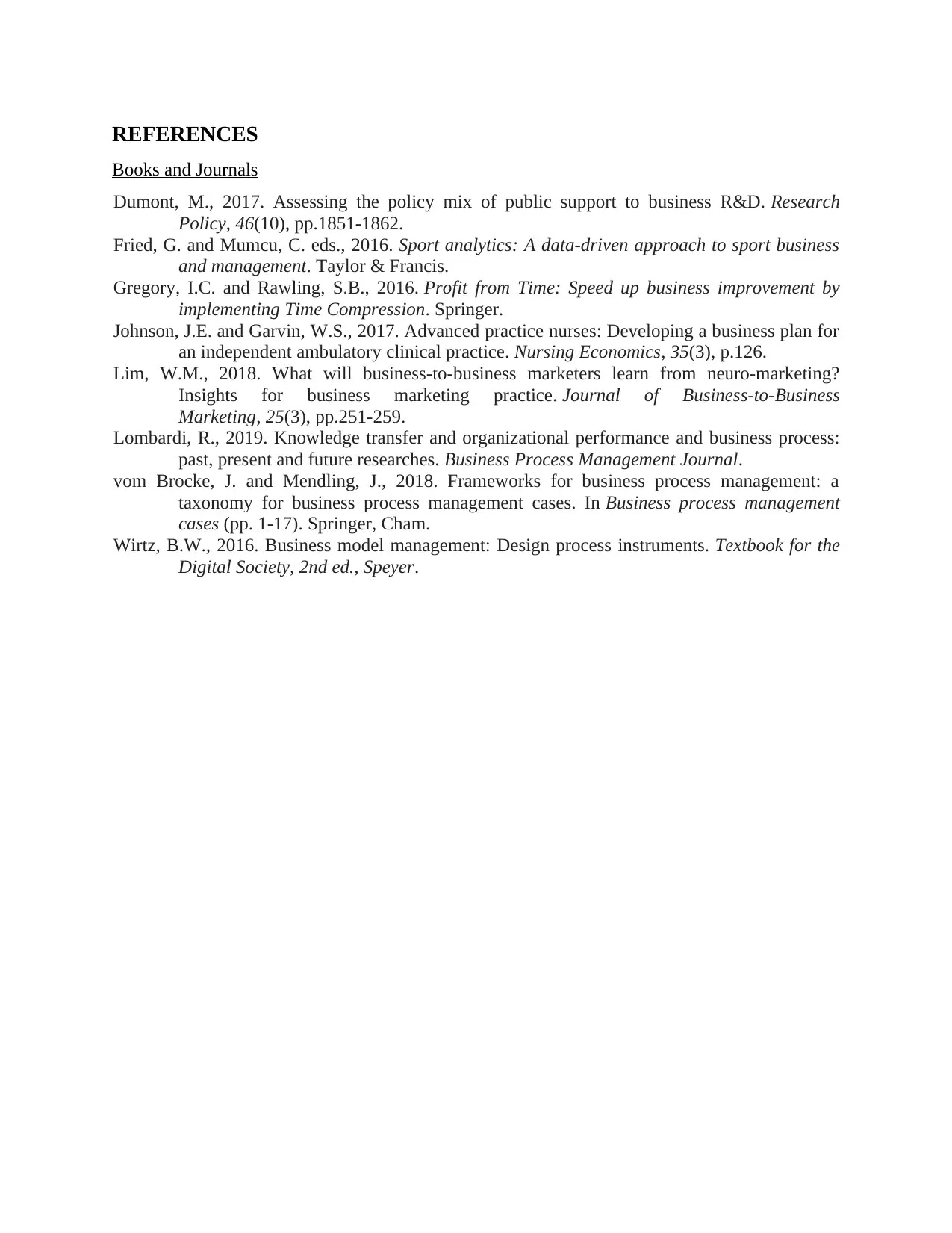
REFERENCES
Books and Journals
Dumont, M., 2017. Assessing the policy mix of public support to business R&D. Research
Policy, 46(10), pp.1851-1862.
Fried, G. and Mumcu, C. eds., 2016. Sport analytics: A data-driven approach to sport business
and management. Taylor & Francis.
Gregory, I.C. and Rawling, S.B., 2016. Profit from Time: Speed up business improvement by
implementing Time Compression. Springer.
Johnson, J.E. and Garvin, W.S., 2017. Advanced practice nurses: Developing a business plan for
an independent ambulatory clinical practice. Nursing Economics, 35(3), p.126.
Lim, W.M., 2018. What will business-to-business marketers learn from neuro-marketing?
Insights for business marketing practice. Journal of Business-to-Business
Marketing, 25(3), pp.251-259.
Lombardi, R., 2019. Knowledge transfer and organizational performance and business process:
past, present and future researches. Business Process Management Journal.
vom Brocke, J. and Mendling, J., 2018. Frameworks for business process management: a
taxonomy for business process management cases. In Business process management
cases (pp. 1-17). Springer, Cham.
Wirtz, B.W., 2016. Business model management: Design process instruments. Textbook for the
Digital Society, 2nd ed., Speyer.
Books and Journals
Dumont, M., 2017. Assessing the policy mix of public support to business R&D. Research
Policy, 46(10), pp.1851-1862.
Fried, G. and Mumcu, C. eds., 2016. Sport analytics: A data-driven approach to sport business
and management. Taylor & Francis.
Gregory, I.C. and Rawling, S.B., 2016. Profit from Time: Speed up business improvement by
implementing Time Compression. Springer.
Johnson, J.E. and Garvin, W.S., 2017. Advanced practice nurses: Developing a business plan for
an independent ambulatory clinical practice. Nursing Economics, 35(3), p.126.
Lim, W.M., 2018. What will business-to-business marketers learn from neuro-marketing?
Insights for business marketing practice. Journal of Business-to-Business
Marketing, 25(3), pp.251-259.
Lombardi, R., 2019. Knowledge transfer and organizational performance and business process:
past, present and future researches. Business Process Management Journal.
vom Brocke, J. and Mendling, J., 2018. Frameworks for business process management: a
taxonomy for business process management cases. In Business process management
cases (pp. 1-17). Springer, Cham.
Wirtz, B.W., 2016. Business model management: Design process instruments. Textbook for the
Digital Society, 2nd ed., Speyer.
1 out of 8
Related Documents
Your All-in-One AI-Powered Toolkit for Academic Success.
+13062052269
info@desklib.com
Available 24*7 on WhatsApp / Email
![[object Object]](/_next/static/media/star-bottom.7253800d.svg)
Unlock your academic potential
Copyright © 2020–2025 A2Z Services. All Rights Reserved. Developed and managed by ZUCOL.





